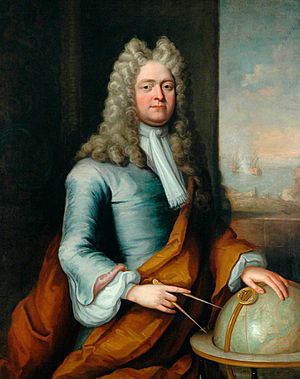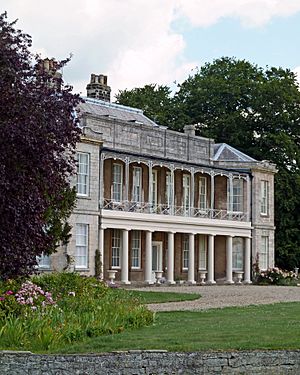Robert Fairfax (Royal Navy officer) facts for kids
Quick facts for kids
Robert Fairfax
|
|
|---|---|

Portrait of Fairfax c.1720
|
|
| Born | February 1666 Newton Kyme, Yorkshire |
| Died | 17 October 1725 (aged 59) |
| Allegiance | |
| Service/ |
|
| Years of service | 1687–1708 |
| Rank | Rear Admiral |
| Commands held | Conception Prize Pembroke Ruby Newark Cornwall Severn Cambridge Restoration Somerset Kent Berwick Torbay Barfleur Albemarle |
| Battles/wars | Nine Years' War |
Robert Fairfax (February 1666 – 17 October 1725) was an important rear admiral in the Royal Navy and a politician. He served during major conflicts like the Nine Years' War and the War of the Spanish Succession. Fairfax was known for his bravery and leadership at sea. Later in life, he became involved in local politics in York.
Contents
Robert Fairfax was born in February 1666 in Newton Kyme, a village in Yorkshire, England. He was the second son of William Fairfax and Catherine Stapleton. His grandfather was Sir William Fairfax, a well-known soldier.
Robert first went to sea in 1681 on a merchant ship called the Mary. He sailed to the Mediterranean Sea twice. In 1687, he joined the Royal Navy as a volunteer on the ship Mary, which was the main ship of Sir Roger Strickland.
Robert Fairfax quickly moved up in the navy. He served on many different ships, taking part in important battles and missions.
In 1689, Fairfax became a lieutenant on the Bonaventure. He fought in the Battle of Bantry Bay and helped relieve the city of Derry. In 1690, he was also present at the Battle of Beachy Head. Later that year, he was given command of the Conception Prize. For two years, he patrolled the waters near Boston in New England, protecting ships from French privateers.
Protecting Trade Routes
In 1693, Fairfax commanded the Pembroke, a 60-gun ship. He then took command of the Ruby, a 48-gun ship, to protect trade along the coast of Ireland. He bravely captured a French privateer ship called the Entreprenant. This victory earned him a promotion in 1694 to command the Newark, an 80-gun ship. He later commanded the Cornwall, helping to protect convoys in the English Channel and near Portugal until the Peace of Ryswick ended the war.
Missions in the Baltic and Vigo
In 1699, Fairfax took command of the Severn. The next year, his ship was part of a fleet that went to the Baltic Sea to help keep peace between Denmark and Holstein. After returning, he commanded the Cambridge. In 1702, he was given command of the 70-gun ship HMS Restoration. This ship joined a squadron that tried to stop French ships near A Coruña. Later, Fairfax and his crew helped bring captured ships back to England from Vigo.
Heroism at Granville
In 1703, Fairfax commanded the Somerset and then the Kent. As flag-captain to Rear-admiral Thomas Dilkes, he played a key role in capturing or destroying many French merchant ships at Granville. For this important service, Fairfax and the other captains received a special gold medal.
Capturing Gibraltar and Battle of Málaga
In 1704, Fairfax commanded the Berwick, a 70-gun ship. He joined Sir George Rooke and the main fleet in Lisbon. The Berwick was one of the ships that helped capture Gibraltar on July 23. For his part in this victory, Queen Anne gave Fairfax a silver cup. The Berwick also fought bravely in the Battle of Málaga on August 13, where it suffered heavy damage and many casualties.
Siege of Barcelona
Fairfax was then appointed to the Torbay. In this ship, he sailed to the Mediterranean under Sir Cloudesley Shovell. He helped in the reduction of Barcelona. The Torbay provided guns and sailors to help capture the fort of Montjuich. Fairfax also commanded the bomb vessels, which fired on the city and helped the attackers. After Barcelona surrendered, the fleet returned to England.
In 1706, Fairfax commanded the Barfleur and was in charge of naval operations in the Thames and Medway. He later moved to the Albemarle and served as commander-in-chief at Portsmouth. In 1707, he was replaced by Sir John Leake.
Political Challenges and Retirement
After the death of Sir Clowdisley Shovell in 1707, there was a promotion of flag-officers. Fairfax was supposed to be promoted to Vice Admiral of the Blue. However, due to political reasons, Lord Dursley, who was less experienced, received the promotion instead.
Fairfax was very upset by this unfair treatment and refused to serve further. Prince George arranged for him to become a rear-admiral and receive half-pay. He was also made a member of the Council of the Lord High Admiral in 1708. However, when Prince George died later that year, Fairfax retired completely from naval life.
Life as a Politician and Landowner
In 1713, Robert Fairfax was elected to Parliament for the city of York. However, he lost his seat in the next election. He became an Alderman of York and was later elected Lord Mayor of the city in 1715. He spent the rest of his life serving in these local roles and managing his large estates.
Family Life and Legacy
In 1694, Robert Fairfax inherited the Steeton and Newton Kyme estates after his older brother passed away. That same year, he married Esther Bushell, the sister of his first captain. She was ten years older than him, but he had liked her since he was a boy.
Robert Fairfax passed away on October 17, 1725, and was buried in the church at Newton Kyme, where he had been christened. His wife lived for another ten years. He had two children: a daughter who married Henry Pawson, and a son named Thomas. Thomas's family still owns the estates of Steeton, Newton Kyme, and Bilbrough. There are three portraits of Admiral Fairfax that are still kept by his family today.
Images for kids




